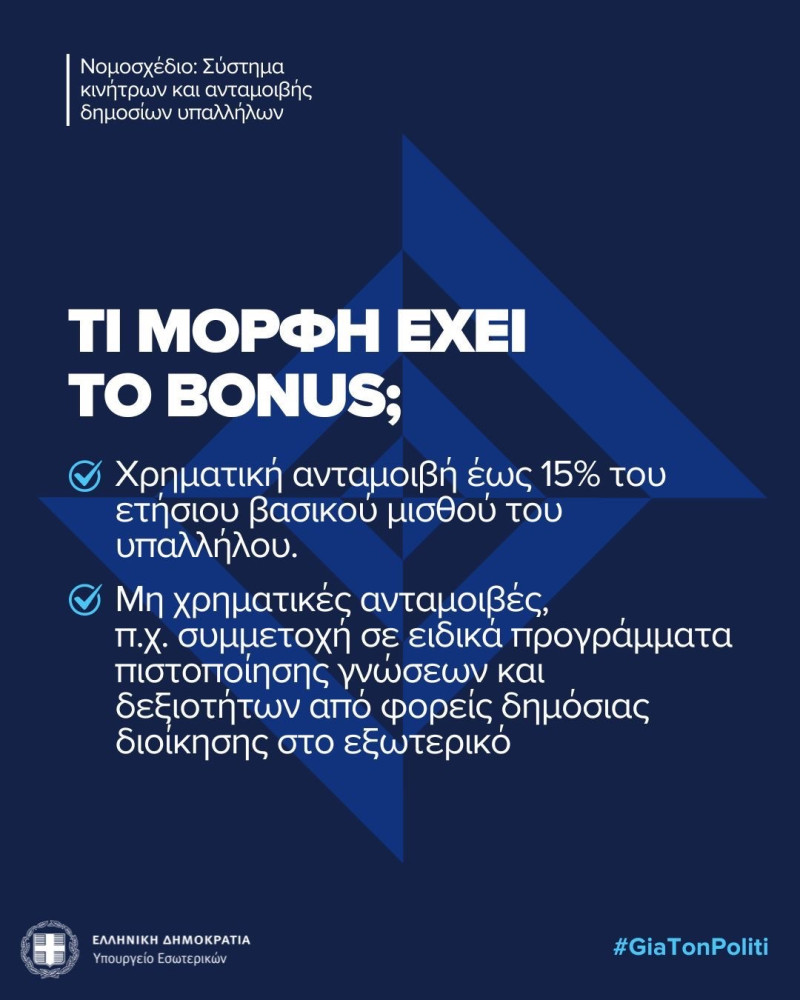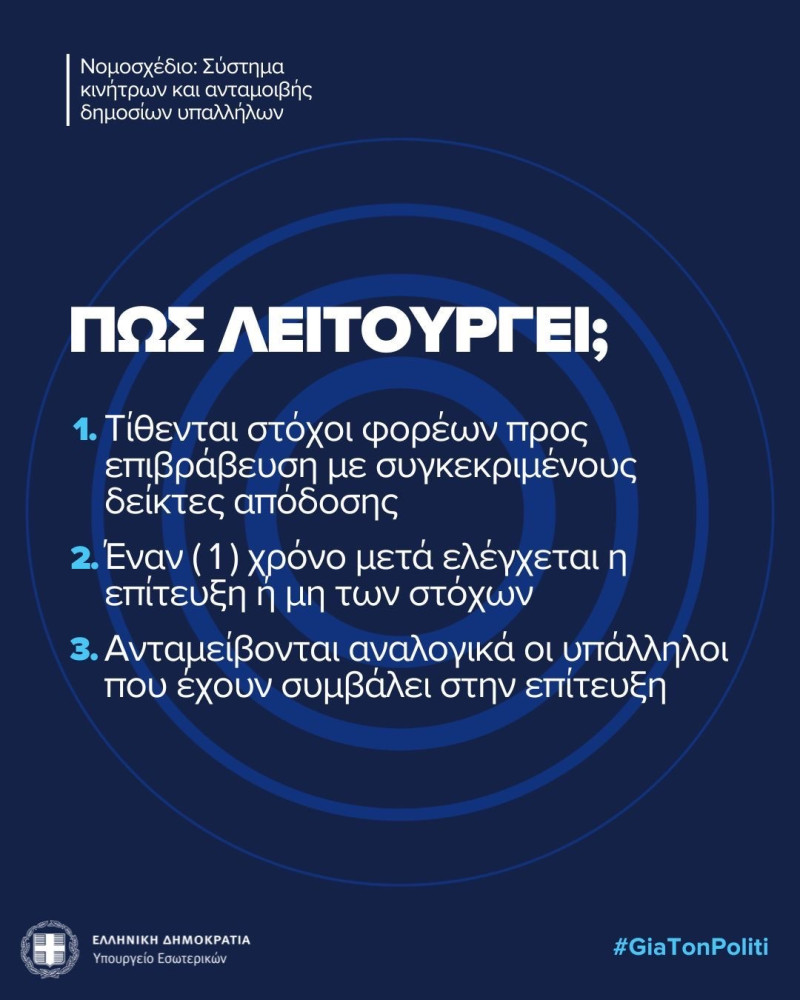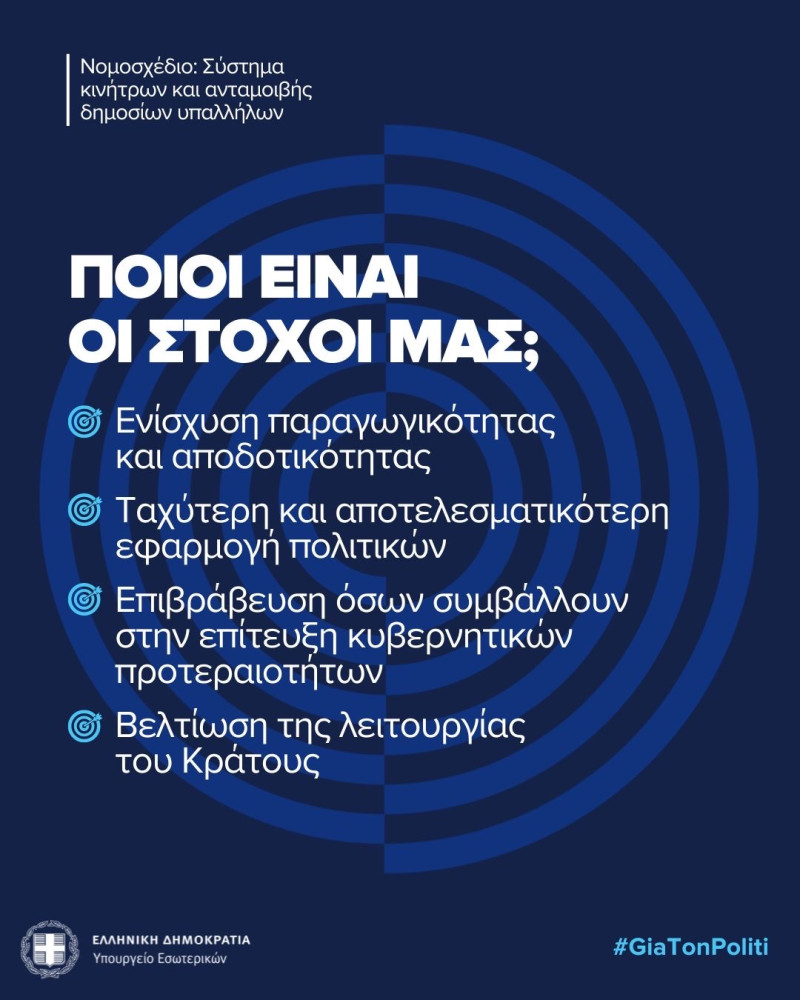The aim is to serve the public faster and to increase the efficiency of public servants – “We invest in our people”, said the Minister of the Interior Niki Kerameos
They presented the new incentive and reward system that will be applied to the public bodies the Minister of the Interior, Niki Kerameosand the Deputy Minister of the Interior, Vivi Charalambogianni, in the Council of Ministers.
The aim of the new system is to enhancing the productivity and efficiency of civil servants in order to achieve the fastest and most effective implementation of reforms with the ultimate goal of optimal service to citizens.
More specifically:
• A new framework is being created, fully connected to the existing target setting and evaluation system and the Ministries’ Annual Action Plans.
• A scope of application is provided for the productivity bonus that includes all agencies subject to targeting – evaluation.
• A clear methodology for determining the eligible targets and a uniform methodology for awarding the reward is defined.
• An Incentives and Remuneration Committee, a Department of Incentives and Remuneration in the Ministry of Interior and a Remuneration Information System are established for the technical support of the process.
• Non-monetary rewards are also introduced.
How rewards will be determined
At the beginning of each year, the objectives to be rewarded by the State bodies will be determined, following processing by the Incentives and Remuneration Committee, which is made up of officials and the competent Secretaries General, based on the priorities per Ministry. As long as these goals are achieved, employees who have substantially contributed to their achievement will receive the productivity bonus.
Eligible employees can receive a cash reward of up to 15% of their annual base salary. The selection of the eligible employees and the amount of reward per beneficiary is carried out by their superiors and not by the political leadership, based on their contribution to the achievement of the specific objectives.
40% of the reward amount is distributed equally to the eligible employees who worked to achieve the target and 60% is distributed non-horizontally and in relation to the specific contribution of each employee to the achievement of the goal. The bill also provides safeguards to prevent the bonus from turning into a horizontal allowance while also introducing non-monetary rewards, which can for example take the form of participation in special knowledge and skills certification programs by public administration bodies abroad.
Benefits for civil servants
The benefits of this legislation are the following:
• Rewarding worthy and efficient civil servants – Introducing healthy incentives to the Public
• Enhancing the efficiency of the Public Sector – enhancing collaboration between services that serve common goals
• Better public services – better service to the citizen
• Faster implementation of Ministry reforms and priorities
• Strengthening the image and attractiveness of the Public Sector as an employer
The Minister of the Interior Niki Kerameos stated: “We are introducing healthy incentives to the State. We invest in our people, we reward civil servants who are particularly efficient. We are changing the perception of the State through a rich reform network that aims to create a more modern, friendlier, more efficient state that will better serve the citizen.”
The Deputy Minister Vivi Charalambogianni stated: “Today we are fulfilling another of our pre-election commitments with the new incentive and reward system that is part of our broader strategy for the management of human resources in the public sector. We inextricably link the new legislation with the target setting and create an environment of motivation, meritocracy, transparency and efficiency, for the benefit of the citizens.”
Frequently asked questions and answers
1. What is the new incentive and reward system for civil servants (productivity bonus)?
• This is a new reward system for civil servants for their substantial contribution to the achievement of identified and measurable goals, fully connected to the existing target setting – evaluation system and to the Ministries’ Annual Action Plans.
• The aim of the new system is to enhance the productivity and efficiency of civil servants in order to achieve the fastest and most effective implementation of reforms with the ultimate goal of optimal service to citizens.
2. What are the benefits of the productivity bonus?
• The benefits of this legislation are the following:
o Rewarding worthy and efficient civil servants – introducing healthy incentives to the Public.
o Enhancing the efficiency of the Public Sector – strengthening cooperation between services that serve common goals.
o Better public services – better service to the citizen.
o Faster implementation of Ministry reforms and priorities.
o Strengthening the image and attractiveness of the Public Sector as an employer.
3. Who does the productivity bonus apply to?
• All employees of agencies subject to targeting – evaluation, such as e.g. Ministries, municipalities and regions, hospitals, are potential beneficiaries of the productivity bonus.
• In order for an employee to receive the productivity bonus, they must have made a substantial contribution to the achievement of a goal that has been selected for reward.
4. How are the targets to be rewarded selected?
• The targets set for each public service result from the existing target setting process for public bodiesin which the projects of the Ministries’ Annual Action Plans are integrated and specialized by General Directorate, Directorate and Department.
• At the beginning of each year the, for reward, objectives of the agencies will be determinedfollowing processing by the Incentives and Remuneration Committee, which is made up of officials and the competent Secretaries General, based on the priorities per Ministry.
5. How is the degree of achievement of the objectives calculated?
• The objectives of the services resulting from the existing process of setting goals for public bodies are formulated in their entirety according to the SMART method.
• In this way, objectives arise which are:
o Specifically,
o Measurable,
o Achievable,
o Related,
o Timed.
• The degree of achievement of the selected objectives to be rewarded is calculated based on specific performance indicators.
• These indicators, as well as the documentary material that proves the progress of the achievement of the selected goals, are recorded in the Reward Information System, implemented for this purpose, with funding from the Recovery and Resilience Fund.
6. How are the eligible employees selected and how is it ensured that it will not end up being a bonus for all?
• The selection of employee beneficiaries and the amount of reward per beneficiary is carried out by their supervisors and not by the political leadership, based on their contribution to the achievement of the specific goals.
• In order for the productivity bonus not to acquire a “bonus” character, a minimum reward amount is determined per employee and maximum number of eligible employees per institution.
• 40% of the reward amount is distributed equally to the eligible employees and 60% is distributed non-horizontally and in relation to the contribution of each employee to the achievement of the goal.
7. What is the amount of monetary reward that employees receive?
• Eligible employees may receive a cash reward up to 15% of their annual basic salary.
• The budget for monetary rewardsunder the new system, amounts to a total of 40 million euros per year.
8. What are non-monetary rewards?
• Non-monetary rewards are granted on a one-time basisannually, to employees who have contributed to the full achievement of objectives and have not received a monetary reward.
• They are granted following thorough recommendations from the employees’ direct supervisors.
• They can, for example, take the form of participation in special knowledge and skills certification programs by public administration bodies abroad.
9. How is objectivity ensured in the process of awarding the productivity bonus?
• The bill introduces a number of safeguards for objectivity in the process of awarding the productivity bonus:
o A methodical way of distributing the reward is foreseenwith specific mathematical formulas explicitly stated in the draft law,
o Employees to receive productivity bonuses are selected by their line managers and not by the political leadership of the Ministries,
o The Reward Information System ensures the fair application of the productivity bonusthrough the monitoring of performance metrics and the necessary documentation,
o The National Transparency Authority is given the opportunity to carry out a sample check of fair distribution and correct payment of the bonus.
Source: Skai
I have worked as a journalist for over 10 years, and my work has been featured on many different news websites. I am also an author, and my work has been published in several books. I specialize in opinion writing, and I often write about current events and controversial topics. I am a very well-rounded writer, and I have a lot of experience in different areas of journalism. I am a very hard worker, and I am always willing to put in the extra effort to get the job done.













